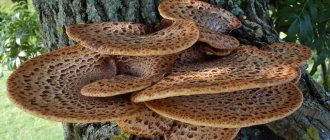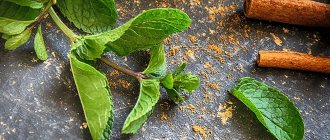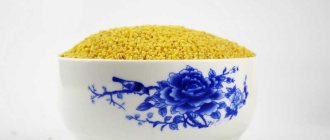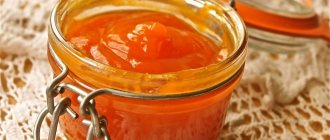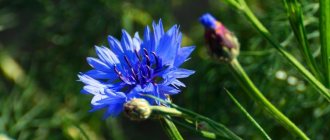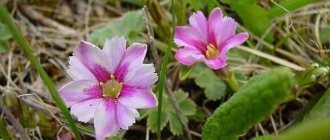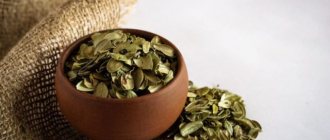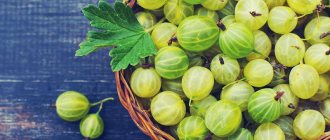Peppermint tea is a refreshing drink infused with the leaves of the honey-bearing English mint, bred by crossing two wild species - spearmint and watermint. There are other names - pepper or cold. Used in pharmacology, cosmetology, perfumery and cooking.
Melissa (lemon balm) is suitable for consumption. Fragrant leaves are brewed separately or in combination with herbs. Black and green tea with the addition of mint is delicious. The plant has beneficial qualities that are revealed when preparing a hot drink. Let's figure out what medicinal properties mint tea has, who it is useful for, and who it is harmful for. We'll tell you about the rules for collecting and preparing raw materials, and share brewing recipes.
Medicinal and beneficial properties
Mint has been used since ancient Rome. For a favorable atmosphere, mint water was sprayed in the house; before meals, the surface of the table was wiped with it to maintain the good mood of household members and guests. Traditional healers have long known the benefits of mint. For various ailments, it was necessary to do inhalations, compresses or brew mint tea, the benefits of which are being widely studied at present.
Benefits of mint tea:
- Normalizes the emotional background, helps get rid of depression, cope with stress.
- Drinking this drink at night is an effective remedy for insomnia and increased anxiety.
- Taking it in the morning fills the body with energy, gives strength and vigor.
- Eliminates constipation.
- Increases brain activity.
- Has a weak diuretic effect, relieves swelling.
- Relieves headaches and toothaches.
- Effective against nausea, vomiting.
- Reduces temperature.
- Eliminates the symptoms of ARVI, relieves cough, promotes sputum discharge.
- Improves digestion.
- Accelerates blood flow. The tea is used to treat varicose veins.
- Normalizes metabolism.
- Lowers blood pressure.
- Helps with fungal diseases of the skin and mucous membranes.
- Reduces foot sweating.
- Stimulates the heart.
- Slows down skin aging, rejuvenates, fights wrinkles due to the high content of antioxidants.
- Promotes the removal of salts.
- Has an antispasmodic effect.
- Has an anticonvulsant effect.
- Helps with flatulence.
- Disinfects the oral cavity and provides fresh breath.
- A good anti-inflammatory agent.
- Increases performance.
- Strengthens the immune system.
You can drink mint tea at any time of the day. Daily consumption in moderate quantities will not harm in the absence of contraindications.
The benefits and harms of mint tea
Mint is one of the types of herbaceous plants, the characteristic feature of which is a strong specific smell, and it cannot be confused with any other aroma. However, the benefits of mint do not end there. The plant contains menthol. It is this substance that provides the medicinal properties of the herb. So, what are the benefits of mint tea:
- Balances the state of the nervous system.
- Protects the heart and blood vessels from stress and emotional overload.
- Helps with insomnia and migraines.
- Has an astringent, expectorant effect.
- Relieves attacks of nausea and vomiting.
- It is a powerful diuretic that helps remove stagnant water from the body.
- Promotes weight loss.
- Relieves flatulence.
- Dilates the coronary vessels of the heart (with angina pectoris).
- Included in many choleretic preparations for cholecystitis, hepatitis, cholelithiasis, cholangitis.
- Has anti-inflammatory effect.
- Fights seasickness.
- Makes it easier to bear the heat.
- Reduces symptoms of colds.
Peppermint tea has many beneficial properties
Beneficial effects
Menthol has a relaxing effect on the body. To relieve nervous tension after a hard day, just drink a cup of mint tea and relax a little. Usually 5-10 minutes are enough to feel completely different. This quick and effective way to recover can also be used during your lunch break at work.
In the evening, tea with mint will have a relaxing effect on all the muscles of the body and provide a restful, healthy sleep. After a cup of aromatic drink, you need to give up the computer, TV, and it’s better to read something. This will relax you and give you the opportunity to fall asleep faster and more soundly.
Mint has another important effect - it increases the ability to concentrate.
In scientific circles, this has long been confirmed by experiments and research. In addition, it is not necessary to even take mint internally. It is enough to have a flowerpot with this plant on the windowsill. Or put the fragrant branches in a vase with water so that they retain the strength and freshness of the aroma longer.
Another effect of taking mint tea is weight loss. The thing is that the drink suppresses appetite well and accelerates metabolic processes. Drinking a cup of green mint tea in the morning can have a significant impact on your metabolic efficiency throughout the day. At the same time, of course, you cannot refuse to play sports.
Peppermint tea is great for colds. Brew the herb, add lemon, honey. This drink will eliminate painful irritation in the throat and reduce the inflammatory process in its mucous membranes. Mint can serve as an excellent anti-sweat remedy. But at high temperatures you should not drink menthol tea. In such a state, on the contrary, it is very important to get rid of the “seven sweats” from yourself. And for a minor cold, the drink is ideal.
There are certain contraindications for taking mint tea
Contraindications
We should not forget about contraindications. So, who does not want to drink tea in large quantities:
- hypotensive people, as it lowers blood pressure;
- for people engaged in vigorous activity – causes drowsiness;
- with hiatal hernia;
- as well as kidney stones and gastroesophageal reflux disease;
- During pregnancy and lactation, consultation with a doctor is necessary.
How often you can drink mint tea in a particular case should be decided with your doctor. Also, do not forget about allergic reactions, which now happen very often. Therefore, you should not abuse the drink, and sticking to the “golden mean” will not hurt in this either. It is recommended to drink mint infusion every morning for chronic pathologies of the liver, stomach and gall bladder.
Effect on the female body
The properties of mint in tea are such that they make this drink very useful and necessary for women at any age. Our life is full of stress, and tea with menthol will help relieve nervous tension in time. A very useful habit is to drink a fragrant drink at the end of the day or after strong emotional experiences.
What else is mint tea good for? Menthol stimulates the production of hormones in a woman, which makes her younger and more attractive, and relieves many diseases. By including an aromatic drink in your daily menu, you can regulate your menstrual cycle and ease menopause. In addition, it will help a woman get rid of excess body hair due to its effect on hormonal balance.
Mint tea has a beneficial effect on the female body
Mint tea during pregnancy
Carrying a child is a special period when a lot of attention is paid to what a woman eats or drinks. Each step in this direction is carefully weighed, since all possible risks for the developing child in utero are taken into account. Herbal tea with mint can be drunk by pregnant women if it is one cup a day. In this case, the drink will be not only safe, but also healthy:
- It will calm the mother’s nervous system, which will have a positive effect on the baby’s development.
- Relieves symptoms of toxicosis.
- It will improve the functioning of the gastrointestinal tract, including relieving constipation.
- It will cure colds without allowing the use of synthetic medications.
- It will remove excess fluid and relieve swelling.
It is advisable to take short breaks (1-2 days) and replace the aromatic drink with something else. Mint contains substances that can accumulate and cause undesirable effects for a pregnant woman:
- increased uterine tone;
- drop in blood pressure;
- manifestation of an allergic reaction;
- decreased milk production;
- for problems with kidneys and liver.
Mint contains phytoestrogens, which have a structure and effect similar to female sex hormones. They can affect the tone of the uterus, cause premature labor or terminate the pregnancy.
Effect on men
Tea with menthol, when consumed in moderation, has no side effects on women. But for men, it’s best to beware of aromatic additives in tea, or give preference to other options for a hot drink.
The fact is that mint reduces the production of testosterone (sex hormone) in the body. Although some men with an irrepressible libido will benefit from such side effects.
You can prepare mint tea according to different recipes, including with additives
Features of benefits and harm for women and men
For women
Mint has a positive effect on the female body:
- Normalizes hormonal levels. Drinking mint tea is beneficial for women with high testosterone. Under the influence of active components, the concentration of the male hormone decreases, hair growth on the body and face slows down, and the menstrual cycle improves.
- Helps reduce PMS symptoms.
- Reduces the frequency of hot flashes during menopause, alleviates the general condition.
- Improves skin and hair health, especially during puberty.
- Helps eliminate inflammation of the pelvic organs.
- Useful for uterine fibroids.
Mint tea leaves are used to tone oily skin and tighten pores. To do this, freeze it in bags or forms and wipe your face with an ice cube every day after washing.
If you are experiencing infertility, limit your consumption of mint infusion to 1 cup per week. The active components of the herb inhibit the reproductive ability of eggs. You should not take tea when planning a pregnancy, if there have been cases of miscarriage or fetal death.
For men
There is an opinion that mint causes sexual impotence. Scientists have found that under the influence of a complex of chemicals in the leaves, the production of male sex hormones is suppressed. Abuse of a refreshing drink leads to a decrease in erection and a decrease in sperm activity.
But tea with mint shoots in moderation is beneficial for the male body. During intense mental or physical work, drink 1-2 cups of aromatic drink a week with the addition of lemon and linden honey. This will help you relax and restore expended energy. Boys are allowed to give fresh infusion in moderate quantities to strengthen the body's defenses.
Benefits of mint tea for the body
Peppermint tea is beneficial for humans. The benefits are as follows:
- calms, relieves anxiety, improves sleep;
- activates brain activity;
- disinfects;
- relieves pain. Relieves headaches and joint pain. Reduces cold symptoms (nasal congestion, body temperature);
- reduces blood pressure;
- helps with diseases of the digestive system. Relieves stomach colic and nausea, reduces gas formation in the intestines;
- restores a weakened body;
- strengthens the immune system.
You should not drink mint tea if you have low blood pressure.
Drinking a drink with mint can also harm a person. Menthol in tea causes allergies. You should not drink tea with low blood pressure, it causes lethargy and dizziness. Contraindicated for those suffering from varicose veins and heartburn. Do not take for children under 5 years of age, pregnant or lactating women.
Pregnant and lactating
Doctors advise avoiding taking peppermint decoctions while pregnant . Active compounds can cause contractions of the uterine walls, which can lead to early miscarriage or premature birth in the third trimester.
Melissa is safer during pregnancy and breastfeeding. Lightly brewed tea with lemon balm reduces nausea during toxicosis, improves mood, eliminates bloating, and prevents the development of postpartum depression.
To stimulate lactation, it is recommended to drink 100 ml of the drink per day 3 times a week.
Excess menthol has the opposite effect - milk production stops. A nursing mother should not overuse mint infusions. During hyperlactation, 2 cups of the drink will help avoid milk stagnation, relieve pain in the mammary glands, and prevent the development of mastitis.
It is allowed to include lemon balm tea in the diet from 2 months after birth. In this case, it is necessary to monitor the reaction of the newborn. If signs of allergies, colic, or indigestion appear, the drink should be discarded.
Recommendations from nutritionists for losing weight
Green tea with mint is recommended as an aid to weight loss. Chemical elements in the plant have a positive effect on metabolic processes and accelerate metabolism.
Weight loss is caused by:
- choleretic effect;
- normalization of intestinal microflora;
- removal of toxic compounds and toxins;
- suppression of cravings for sweets.
Proper nutrition in combination with a drink made from mint leaves helps you quickly lose extra pounds.
Not only an infusion of fresh or dry mint will help you lose weight. You can add 2 drops of natural peppermint essential oil to freshly brewed green, black or herbal tea. Use the product 15 minutes before meals.
Composition of mint tea
Peppermint tea contains a lot of vitamins, microelements and other useful substances:
- essential oils, the main one in mint tea is menthol. Its content in mint is maximum. It relieves unpleasant symptoms of respiratory diseases;
- zinc, selenium, manganese – microelements that make up cells;
- organic acids. Due to their activity, the condition of nerve cells is normalized;
- flavonoids. They have a stable effect against pain and spasms;
- vitamin complex (main: A, C, group B, PP,).
All substances contained in mint tea act as invisible soldiers on the battlefield against diseases, bacteria and viruses.
Calorie content of mint tea
Mint tea is an extremely low-calorie product. It contains only 8.4 kcal per 100 grams.
Chemical composition, calorie content
The plant owes its healing properties to its rich composition. Flowers, stems and leaves contain:
- essential oil;
- resins;
- phytosterols;
- saponins;
- tannins;
- rhamnose;
- glucose;
- arginine;
- carotene.
Along with these substances, acids are present:
- ursolic;
- chlorogenic;
- vinegar;
- valerian;
- coffee shop;
- oleanolic;
- ascorbic acid
The main component of mint oil is menthol. Substances such as carvone, limonene, and citral are active.
The aromatic herb is enriched with vitamins E, D, A, PP, and contains B vitamins. It contains useful mineral compounds:
- iron;
- sodium;
- manganese;
- copper;
- phosphorus;
- zinc;
- calcium;
- magnesium.
The energy value depends on the form in which mint is consumed.
| View | Calorie content per 100 g, kcal | Proteins, g | Fats, g | Carbohydrates, g |
| Fresh | 49 | 3,7 | 0,4 | 8 |
| Dried | 285 | 19,9 | 6 | 22,2 |
| Tea without sweetener | 8,38 | 0,5 | 0,1 | 1,7 |
Application in medicine
Menthol contained in mint oil is used in the production of drugs for the treatment of diseases of the respiratory and cardiovascular systems, neuralgia, and dermatological lesions. The benefits of mint tea for various diseases have been proven, but for certain diagnoses, consumption has a negative effect on well-being. Let's figure out how the drink works for this or that pathology.
Diabetes
Substances released from mint leaves when brewed lower blood sugar levels. It is recommended to drink 250 ml of infusion 3 times a day. Sorbitol is allowed to be used as a sweetener. To prevent the development of diabetes, 2 cups a day before meals is enough.
Pancreatitis
Peppermint tea is one of the effective herbal remedies for inflammation of the pancreas.
The following infusion is used:
- In an enamel bowl, mix dried wormwood, yarrow, mint, fennel and immortelle in equal proportions, add cold water. For 1 liter of water, 30 g of each ingredient.
- Place the container in a water bath and cover with a lid.
- After half an hour, strain the mixture and cool.
- Take 200 ml twice a day 20 minutes before meals.
Treatment is carried out over a two-week course, then a break of 10 days, and repeated.
The collection of herbs eliminates aching and cramping pain, reduces inflammation.
Gastritis
Teas and decoctions based on the leaves of this plant have a gentle effect on the irritated surface of the stomach, soothing heartburn and pain. Menthol has a destructive effect on the cause of gastritis - the bacterium Helicobacter pylori. Daily use helps relieve unpleasant symptoms.
To prepare you will need:
- dill seeds - 2 tsp;
- yarrow - 2 tsp;
- St. John's wort - 2 tsp;
- English mint - 4 tsp.
Mix the ingredients and add 0.8 liters of water. Cover with a lid and simmer in a water bath for 1.5 hours. Strain the cooled broth. Course of administration: 14 days, 1 glass of liquid on an empty stomach.
If the acidity is low, take mint drinks with caution and follow a strict dosage.
To increase appetite, eliminate burning and spasms, use the following remedy:
Mix valerian root, peppermint and knotweed in equal proportions, pour hot, but not boiling water at the rate of 3 tbsp. l. raw materials per 1 liter of water. Leave in a thermos for 10–12 hours. We filter. Drink warm in the morning and before bed, 100 ml for 10 days.
Such infusions are also useful for stomach and duodenal ulcers.
Cold
Hot tea with mint is one of the folk remedies for colds. Fever, dry cough, chills, and runny nose go away within 2–3 days if you start taking the drink from the first day of illness. To enhance the effect, add lemon and a spoonful of fresh honey.
For respiratory infections, it is recommended to do morning and evening inhalations. To do this, pour 1 liter of boiling water into a bowl, add 3-4 drops of essential mint oil. Cover your head with a towel and inhale the steam for 5 minutes.
Hangover
Mint tea is the best way to get in shape the morning after a feast.
There are several proven recipes that can get you back on your feet in a short time, even after drinking a large number of strong drinks:
- An infusion of mint and chamomile flowers will relieve tremors, headaches, and nausea. The grass is mixed in equal proportions. Add 2 tsp to 300 ml of boiling water. dry mixture. Leave for 20 minutes, filter. You need to drink it warm.
- You can clear your mind and relieve dizziness using a solution with mint oil. Add 5 drops of ether to a glass of cool water. Drink in one gulp.
- An effective remedy for the symptoms of alcohol poisoning is a herbal mixture of yarrow, lemon balm, St. John's wort, wormwood with the addition of angelica root, calamus and juniper fruits. Brew the mixture in a thermos at the rate of 5 tsp. raw materials per 1 liter of water. Let it sit for 1.5 hours. You can take the healing infusion hot or cold.
It is forbidden to add sweeteners, this will reduce the effect.
To prevent a hangover before drinking alcohol, drink the following drink:
- Mix 1 tsp. black or green tea with 1 tsp. mint.
- Add 1.5 tbsp. l. lemon juice.
- Pour in 300 ml of hot boiled water.
- Let it sit for 15 minutes.
- Filtering.
Drink chilled.
Poisoning
If the body is intoxicated, severe diarrhea, vomiting, nausea, and clouding of consciousness are possible. The problem can be eliminated by timely gastric lavage, taking sorbents, and blood purification with droppers with a special composition.
You can relieve symptoms at home with mint tea:
- Mix the crushed St. John's wort herb in equal proportions with oregano and mint leaves.
- Pour 1 tbsp. l. collecting 1 liter of boiling water.
- Let it sit for 20 minutes.
The product is taken warm, 100 ml every half hour.
Hypertension
Increased pressure in the arteries leads to the development of heart pathologies. For the prevention and treatment of hypertension, it is recommended to take infusions with peppermint.
The beneficial qualities of menthol, flavonoids, and minerals in the plant help improve the patient’s condition:
- Remove excess cholesterol, cleanse and strengthen the walls of blood vessels.
- Dilate blood vessels, lower blood pressure.
- Increases the heart's endurance to physical activity.
- Raises venous tone.
- Promotes the production of blood cells.
- Reduce the risk of internal bleeding.
- Normalizes heart rate.
- Eliminates squeezing headaches.
Drink 2 times a day for 3 weeks, then take a week break and repeat the course. Instead of sugar, sweeten your drink with honey or drink it unsweetened.
Varicose veins
The advisability of using mint for varicose veins is currently the subject of controversy and disagreement in the medical community. In recent years, studies have been conducted that have proven the preventive benefits of the plant.
The tendency to the disease is 2 times more likely to occur in women; people over 30 years of age with a sedentary lifestyle are the most vulnerable. Daily consumption of mint tea will not allow the veins to lose tone and elasticity, and will prevent the onset of the disease - heaviness in the legs, swelling, burning sensation.
If the disease is at an early stage, mint infusion in combination with topical medications will prevent the progression of varicose veins. Under the influence of active components, there will be no stagnation of venous blood, blood flow in the capillaries will accelerate.
The beneficial substances of peppermint will prevent inflammation of blood vessels, the appearance of vascular networks, and asterisks. When the disease is advanced, the formation of venous nodes, swelling of the veins, and aching pain are observed. In this case, frequent consumption of a drink with mint can aggravate the condition due to the vasodilating properties of the herb. To relieve pain, you are allowed to drink 200 ml per week after medical consultation.
Cancer prevention, research
Due to the increase in cancer incidence over the past 15 years, experts have studied the effect of the active substances of peppermint leaves on the formation and development of pathogenic cells of various types of cancer.
In 2009, a study was conducted on the cellular susceptibility of prostate cancer to menthol. During the experiments, the harmful effect of the substance on the affected cells was established.
In 2011, the effect of 5 herbs and herbs on the growth of colon cancer cells was studied. The results of the study proved the antitumor activity of lemon and peppermint. In combination with sage, the inhibitory effect of the herb on the spread of the disease increased.
In the USA, through experiments with a group of volunteers, it was found that mint extract reduces the frequency and severity of side effects in patients receiving chemotherapy.
In 2021, in Ohio, 50 volunteers diagnosed with leukemia underwent a study to determine the effect of aromatherapy on the aggressiveness of symptoms associated with leukemia. Patients who had undergone intensive chemotherapy fell asleep in rooms filled with the aromas of chamomile, peppermint, and lavender. After a few weeks, it was concluded that the patients' sleep returned to normal, depression and shortness of breath went away, and their appetite improved.
In 2021, scientists analyzed the effect of mint tea on the behavior of several human enzymes. Daily consumption of the drink showed the cumulative activity of the main active substances of the plant in relation to medications used simultaneously with the consumption of tea. The pharmacokinetics of drugs changed, metabolic processes accelerated. The results of the study revealed the chemopreventive effect of peppermint infusion against the spread of cancer cells.
Conclusion: the herb is effective, including in tea, as a means of preventing the formation, spread and growth of cancer of various localizations, as well as as a means of reducing the severity of associated symptoms and side effects after aggressive treatment.
Harm and side effects
In some people, mint drink can cause allergic reactions, diarrhea and heartburn. If you abuse herbal tea, a decrease in heart rate and convulsions are possible. It is unsafe to drink the drink if you have a stomach ulcer or diabetes. It is not recommended to drink tea for people with lower esophageal sphincter insufficiency, since mint causes relaxation of the muscular organ.
You should avoid the drink if you have a hernia, gallstone disease, or Parkinson's disease.
May cause heartburn and diarrhea
A possible reaction of the body to mint tea is an upset digestive process. Some people report developing diarrhea and heartburn. Such symptoms are observed when drinking too much.
Causes allergic reactions
In case of individual intolerance, the patient may experience external manifestations in the form of irritation, blisters and ulcers on the legs and arms, and in the oral cavity. Internal reactions of the body include headaches, difficulty breathing, heaviness in the chest and nasal congestion.
Allergies most often occur to fresh leaves of the plant - due to the essential oil in their composition, but can also develop when used in dried or fermented form. People with weak immunity, the presence of chronic diseases and disruption of the digestive system are prone to the development of undesirable effects.
- How to cook pumpkin tasty and quickly
- No-spa - what it helps with: using the drug for pain
- Ear congestion without pain - how to treat. Causes of ear congestion without pain
Lowers sugar levels
Mint decoction reduces the concentration of glucose in the blood. The drink may interact with diabetes medications. Patients who suffer from this disease should drink tea only after consulting with their doctor.
Affects uterine blood flow
Mint stimulates blood flow in the uterus, can lead to detachment of the mucous membrane of the organ, causing its contractions, putting pregnancy at risk. In order not to provoke problems, it is better for pregnant women to avoid using the plant in any form.
When breastfeeding, essential oils enter the baby's body along with milk and lead to heart rhythm disturbances.
As a result, the baby may even experience cardiac arrest. Doctors prohibit breastfeeding women from drinking mint tea. But the plant also has medicinal properties for women. In gynecological practice, it is used for irregular menstrual cycles and severe pain during menstruation.
Enhances the effect of drugs
The drink interacts with medications taken for gastritis, high or low blood pressure and diabetes. Combining these medications with mint tea may cause side effects. They manifest themselves in the form of dizziness, increased drowsiness and weakness, nausea and diarrhea.
Causes drowsiness
Long-term use or overdose of the drink leads to severe lethargy and increased drowsiness, even during the daytime. Tea is not recommended for those who drive or operate complex machinery.
Dangerous for stomach ulcers
Menthol can cause aggravation of ulcerative defects in the mucous membrane of the digestive organ. Doctors prohibit the use of mint during an exacerbation of the disease.
When to collect and how to store
The collection of medicinal greens is carried out during the period of bud formation. Under natural conditions, active flowering begins in June and lasts until the end of September, so mint growing wild or growing in the front garden is collected in May–early June. In some regions this period occurs at the end of summer. Plants grown in a greenhouse have a different life cycle; focus on the beginning of budding.
We collect the upper part with the inflorescences, cut off 1/3 of the length of the stem, leaving the root in the ground. The grass below is hard and not suitable for harvesting. The sprouts are not plucked, but carefully cut so as not to damage the remaining shoots. Choose a dry and sunny day. Optimally evening or afternoon. The maximum benefit comes from a plant aged 2–4 years.
Preparation of raw materials:
- we sort through the collected stems, clear them of dry twigs and spoiled leaves;
- rinse under running water to remove dust, dirt and bugs;
- place it outdoors on a dry cloth surface to dry it from moisture;
- chop if desired.
Methods for harvesting peppermint:
- Drying.
- Freezing.
- Cooling.
- Preparation of sweetener.
How to dry
Methods:
- Spread the mint evenly on a board or oilcloth. When drying in the open air, cover it with gauze. On hot days, we remove the raw materials under a canopy from the harmful effects of the scorching sun. The process takes 3–4 days.
- At home, we lay paper on the windowsill and evenly distribute the grass on top. Due to poor air circulation in the room, we stir the leaves 2 times a day. This method requires more time - 4–7 days.
- We tie the stems with cotton thread, collecting 4-5 branches in bunches. Hang to dry in a well-ventilated room or in the fresh air. Leave it for a week.
The dried product should be stored in cotton or linen fabric bags that allow air to pass through well. Wooden, clay or ceramic dishes with a tight lid are suitable for storing chopped mint. It is necessary to remove the containers in a cool, dry place, away from dampness, to avoid the appearance of mold. Shelf life - 2 years.
How to freeze
Frozen mint will keep for 5–9 months.
Methods for procuring raw materials:
- Place washed, dry mint on cling film, 5-7 stalks at a time. Wrap it tightly in several layers, place it in a plastic bag, and put it in the freezer.
- We place fresh raw materials in tight bags with a zip fastener so that there is little space left when closing. Store in the freezer at temperatures up to 18 degrees.
- Separate the leaves from the branches and chop them finely if desired. Place the greens in bags or ice cube trays and fill with distilled water. Freeze it.
Mint ice is suitable not only for preparing a soft drink, but is also used for wiping the skin around the eyes. This will give your face freshness and remove swelling and bruises under the eyes.
How to cool
The mint can be refrigerated. Cut off 1 cm of the stem and tie a bunch of grass with an elastic band or thread. Pour 250 ml of running water into a jar, put the greens, and wrap the top with cling film.
The disadvantage of this method is that the grass can be stored in the refrigerator for no longer than 4 weeks. If you do not use it during this time, the leaves will begin to rot and become covered with mucus and mold.
How to make sweetener
- Finely chop 500 g mint.
- Add an equal amount of granulated sugar.
- Mix with a blender until smooth.
- Place in clean glass jars and cover with nylon lids.
Store in the refrigerator for 4 months. For tasty and aromatic tea, just add 2 tsp. mixtures.
Methods for harvesting mint
Drying mint
Mint harvesting begins in June, after flowering begins, and continues until the end of July. It is best to collect mint bushes in the morning (after the dew has dried) or in the evening (from sunset to the dew), since high humidity can negatively affect the drying process.
Dirty and damaged leaves should be removed from the total mass, and the collection should be washed and dried thoroughly with a paper towel. Drying itself can be done naturally (in the fresh air) or accelerated (in the oven or microwave).
To dry naturally, the stems are tied into bunches and hung with the leaves down in a dark, dry place with good air circulation. Direct sunlight should be avoided when drying. Processing time is 2 to 3 weeks. As soon as the leaves begin to be easily removed from the stems, drying stops.
Drying in an open oven takes place at a temperature of no more than 75 degrees (at higher temperatures, the leaves lose all their beneficial qualities) for about 15–20 minutes. To prevent the leaves from drying out on the baking sheet, you need to cover it with parchment paper.
Dried mint can be stored for 1–1.5 years. To prevent it from losing its taste, you must use an airtight container made of glass, metal or plastic.
Freezing mint
Freezing mint allows you to preserve its taste and beneficial properties for a long period. For proper freezing, it is necessary to use fresh leaves without damage or stains. The leaves are placed in a bag or cling film, then sent to the freezer.
Mint syrup
Mint syrup is an excellent substitute for fresh leaves when added to tea, coffee and alcoholic beverages, and is also an ingredient in many confectionery products.
To prepare 200 g of syrup you need: 100 g of mint leaves, 250 g of sugar, a pinch of citric acid, 70 g of water.
Coarsely chop the mint, add 125 g of sugar and add citric acid. Leave for 8–10 hours for the leaves to release their juice. Pour 125 g of sugar with water, bring to a boil over low heat and simmer for 4-5 minutes until the sugar is completely dissolved. Pour the mint with the resulting syrup and leave to cool for 5-6 hours, then boil for about 5 minutes, strain through a fine sieve and pour into a pre-sterilized jar, as shown in the video.
Richard “Royal Green” tea, green, 25 bags 96 rub.
Curtis “Cold Tea” tea, green with citrus, 12 pyramids x 3 packs 413 rub.
Chef Tea “Mango-Passion Fruit”, green with additives 90 rub.
Konigin Herbarium “Healthy Sleep” tea, green with additives, 20 sachets 98 rub.
Chinese green tea tied Xian Nyu San Hua (Fairy Scattering Flowers) 390 rub.
Curtis “Sparkling strawberry” tea, green leaf, with additives, 20 pyramids 92 rub.
Tea Etiquette “Green”, 25 bags 37 rub.
Large selection of green tea at TEA.RU
How to choose the right one when purchasing
Mint is sold fresh or dried, as part of herbal teas or in the form of bagged tea.
When purchasing mint tea bags, pay attention to the composition. It must be natural, without dyes or flavors.
Dried herb is sold in pharmacies. The expiration date must be indicated on the packaging.
Please note when purchasing:
- All leaves in the bunch must be clean, without rot, dirt, white coating or damage. Even one bad leaf provokes rapid deterioration of all stems.
- A quality product has leaves that have a uniform, rich green color; they are dense, elastic, without spots or dry edges.
- The cut on the branch should be fresh, not limp and not dry.
- The greens have a characteristic subtle aroma, which intensifies if you rub the leaf with your finger.
- When you touch real mint, it gives off a pleasant chill.
The leaves should not be excessively shiny, this indicates chemical treatment. Avoid buying wet grass that smells damp.
Classic recipes
For traditional mint tea, you will need dry leaves of the plant, water and sweetener.
Preparation:
- Place mint in the teapot at the rate of 1 tsp. per cup plus 1 tsp. on the teapot.
- Boil water, cool to 80 degrees.
- Pour in the grass, cover the kettle with a towel, and leave for 10–15 minutes.
- Pour the finished infusion and add sugar or honey to taste.
Classic Moroccan tea:
- Brew 4 tsp in a ceramic teapot. green Chinese tea, pour 1 liter of boiling water over it.
- After 15 minutes, pour the tea leaves into a bowl, add 2 tbsp. l. Sahara.
- Bring to a boil over low heat.
- Chop 1 bunch of fresh mint and boil for 2 minutes.
- Pour the drink into cups from a height of 30–50 cm to form foam.
There are many ways to make a delicious mint drink. Add the aromatic preparation to green or black tea leaves, combine with other herbs, spices or pieces of berries. Try mint tea brewed according to the suggested recipes.
With citruses
Mint and lemon balm go well with citrus fruits.
A drink with a combination of fruity sourness and herbal freshness saves you from thirst in hot weather, tones you up, and gives you vigor.
For 4 servings:
- green tea - 3 tsp;
- fresh lemon balm - 5 sprigs;
- lemon - 1/2 pcs.;
- orange - 1 pc.;
- honey - to taste.
Preparation:
- Peel the fruits.
- Coarsely chop the zest, mix with tea leaves and slightly mashed lemon balm leaves.
- Fill with hot boiled water and brew for 15 minutes.
- Squeeze the juice from the pulp of orange and lemon and pour it into tea.
- Add honey to taste.
The resulting infusion is well suited for those who want to lose weight. In this case, it is drunk unsweetened and chilled.
With ginger
Ginger-mint tea has a warming effect. With its help, they treat colds, sore throats, and increase immunity. We suggest preparing a special syrup, which can simply be diluted with boiling water to obtain a healing remedy.
Ingredients:
- fresh mint - 300 g;
- sugar - 200 g;
- water - 2 glasses;
- ginger root - 25 g.
Preparation:
- Peel the ginger and cut into slices.
- Coarsely chop the mint.
- Pour sugar into an enamel bowl, add water, and place on low heat.
- Bring to a boil, stirring constantly.
- Add ginger, cook for 5 minutes.
- Add greens and mix.
- Simmer under the lid for 3–5 minutes.
- Remove from the stove, carefully wrap the pan with a towel.
- Leave for 1.5 hours, strain.
Store the syrup in the refrigerator for 2-3 weeks.
With berries
Adding berries gives the tea additional benefits. A drink with mint and blueberries supports visual acuity, with raspberries it has an antipyretic effect, with strawberries or wild strawberries it inhibits the mutation of cancer cells, with sea buckthorn it lifts your spirits.
Raspberry mint
Ingredients:
- fresh or frozen raspberries - 3 tbsp. l.;
- mint - 10–12 leaves;
- water - 1 l;
- honey - to taste.
Preparation:
- Finely tear the mint.
- Mash the raspberries with a spoon and mix with honey.
- Place the ingredients in a French press.
- Fill with hot boiled water.
- Let it sit for 10 minutes.
Bilberry
Ingredients:
- dry mint - 3 tsp;
- blueberries - 2 tbsp. l.;
- sugar - 4 tsp;
- lemon - ½ pc.
- water 80 degrees - 1 l.
Preparation:
- Beat blueberries and sugar in a blender.
- Cut the lemon into thin slices.
- Mix all ingredients in a thermos.
- Brew for 15 minutes.
Strawberry
Ingredients:
- strawberries - 150 g;
- fresh mint - 5 sprigs;
- lemon - 4 slices;
- water - 800 ml;
- sugar - to taste.
Preparation:
- Wash the berries and cut them into pieces.
- We tear the mint into pieces.
- Mix lemon, herbs, strawberries in a teapot and fill with water.
- Steam for 15 minutes.
Pour into cups, add sugar.
With dried fruits
Iced tea with peppermint and dried fruits cools in hot weather and quenches thirst.
Ingredients:
- black Ceylon tea - 4 tsp;
- mint - 4 shoots;
- lemon - ½ piece;
- dried apricots - 8 pcs.;
- raisins - 1 tbsp. l.;
- prunes - 8 pcs.;
- water - 1 l.
Preparation:
- Cut the dried apricots and prunes into small pieces, and the lemon into slices.
- Lightly knead the grass.
- Boil water, cool to 70 degrees.
- Mix all ingredients in a glass teapot and leave to brew until completely cool.
- Filtering.
Spiced
Melissa and mint pair well with warm spices. This drink invigorates, warms, and improves blood circulation.
Ingredients:
- dry mint - 2 tbsp. l.;
- water - 1.2 l;
- cardamom - 2 pcs.;
- allspice - 4 peas;
- ground ginger - ¼ tsp;
- cloves - 2 pcs.;
- lemon, honey - to taste.
Preparation:
- Fry the spices in a hot frying pan for 2 minutes.
- Brew the herb, add spices.
- Let it sit for 15 minutes.
- Crush lemon with honey and add to the finished drink.
Cinnamon
Cinnamon gives mint tea a piquant and unusual taste.
For 2 servings:
- lime - ¼ piece;
- grated lemon zest - 2 tsp;
- mint - 1 tsp;
- black tea leaves - 2 tsp;
- cinnamon - 2 sticks;
- water - 600 ml;
- sugar - to taste.
Preparation:
- Mine mint.
- Combine lemon zest, lime wedges with tea leaves and herbs.
- Grate the cinnamon on a coarse grater and add to the other ingredients.
- Fill with hot boiled water.
- Leave for 20 minutes, strain.
- Add refined sugar.
With honey and cranberries
This drink tastes best when made with black tea. It is rich in vitamin C and is used to prevent respiratory diseases.
Ingredients:
- tea leaves - 2 tbsp. l.;
- dried mint - 1 tbsp. l.;
- cranberries - 150 g;
- water - 1 l;
- linden honey - 2 tbsp. l.
Preparation:
- Boil water, cool for 5 minutes.
- In a thermos, mix the tea leaves with aromatic herbs and fill with water.
- Using a blender, beat the cranberries with honey; if desired, you can replace it with granulated sugar.
- Add the resulting slurry to tea and leave for 15 minutes.
- Filtering.
With rose hips
Mint infusion with rose hips has a diuretic effect and lowers blood pressure in hypertension.
Ingredients:
- mint - 3 tsp;
- green tea - 2 tsp;
- water - 700 ml;
- sweetener - to taste;
- rose hips - 2 tbsp. l.
Preparation.
- We wash the berries and put them in a thermos along with tea leaves and mint leaves.
- Fill with hot water.
- Let it sit for 1 hour.
- Add sugar, honey or stevia powder.
With milk
Milk in combination with mint is poorly absorbed; avoid drinking it before bed.
Ingredients:
- water - 400 ml;
- milk - 400 ml;
- black tea leaves - 1 tbsp. l.;
- mint - 1 bunch;
- sugar - 4 tsp;
- star anise - 2 stars.
Preparation:
- Pour tea and sugar into a saucepan.
- Fill with cold water.
- Bring to a boil, add mint.
- Boil for 3 minutes.
- Add milk, stir until boiling.
- Strain and add star anise.
What herbs does it go with?
You can enhance the healing properties of tea by adding various herbs when brewing according to the classic recipe. Mint and other roots are brewed in a 1:1 or 2:1 ratio to achieve maximum benefits and not spoil the taste of the drink.
Plants that go well with mint:
- Oregano. Helps with asthma, bronchitis and other respiratory diseases. It has a diuretic effect, helps improve blood clotting, and is used as an effective pain reliever.
- Calendula. It has a moderate hypotensive effect, promotes the regeneration of the mucous membranes of the digestive tract, the healing of wounds and ulcers.
- Blooming Sally. Reduces pain during menstruation, relieves irritation during PMS and menopause. Helps accelerate lipid metabolism, has antifungal and bactericidal properties.
- Melissa. The mint variety has similar properties, but is milder. Useful for nervous disorders, stress, helps cope with fatigue and postpartum depression.
- Chamomile. Good for heart patients. Strengthens blood vessels, reduces glucose, normalizes cholesterol levels. An antibacterial agent that effectively fights inflammation of the genitourinary system.
- Currant. The berries and leaves contain ascorbic acid, vitamins and a wide range of minerals. They cleanse the liver and blood of toxins and radionuclides, and stabilize hormonal levels in diabetes.
- Thyme. An aromatic herb with a high content of essential oil. Has bactericidal properties. Natural antispasmodic. Quickly helps with migraines, relaxes, relieves stress.
- Sage. In combination with mint, it provides prevention of cancer. Eliminates candidiasis and inflammatory processes. Improves brain activity.
- St. John's wort. Responsible for the restoration of affected tissues, prevents the spread of viral infections, and is active against a number of bacteria. An effective remedy against arthritis.
- Motherwort. It has sedative properties, helps overcome aggression, anxiety, and fear. Normalizes sleep. Accelerates recovery from prostatitis.
Before use, make sure there are no allergies or contraindications.
